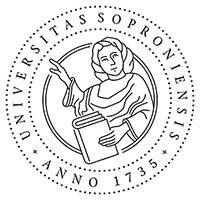The World as Space - Space as World
Abstract
How has the interpretation of the notion of space changed through the centuries? How has it become an interdisciplinary category through its historical development? How does the space experience of the identity manifest itself? These important questions, listed and verbalized after Eco, are raised and left open/ unanswered by my analysis. The 20th century interpreted space as a factor creating sense and as the continuation/elongation of the innermost world of humans. As the projection of the notion of space, the individual creates spatial structures which are understood as independent factors of reality. The experienced space presupposes a certain kind of horizon of knowledge, on the basis of which a specific community is able to define itself. Things do not simply fill up space, but define space itself by their being/existing in space. Modern space is not interpreted as lack but as a continually changing, metamorphosing being, constituted by things existing as places.
References
Bahtyin, Mihail (1976): A tér és az idő a regényben. In: Mihail Bahtyin: Aszó esztétikája. Gondolat, Budapest.
Barthes, Roland (1996): A szöveg öröme. Osiris, Budapest.
Bergson, Henri (2001): Évolution créatrice. PUF, Paris.
Blanchot, Maurice (1988): L’espace littéraire. Gallimard, Paris.
Bourdieu, Pierre (2002): A gyakorlati észjárás. A társadalmi cselekvés elméletéről. Napvilág Kiadó, Budapest.
Carnap, Rudolf (1922): Dér Raum: Ein Beitrag zűr Wissenschaftslehre. Kant-Studien No. 56, Berlin.
Derrida, Jacques (1967): De la grammatologie. Minuit, Paris.
Derrida, Jacques (1991): Grammatológia. Magyar Műhely, Budapest-Párizs.
Eco, Umberto (2009): A lista mámora. Európa, Budapest.
Einstein, Albert (1998): Hogyan látom a világot? Gladiátor, Budapest.
Foucault, Michel (1969; 2001): L’Archéologie du savoir. Gallimard, Paris. A tudás archeológiája. Atlantisz, Budapest.
Gadamer, Hans-Georg (1994): Épületek és képek olvasása. In: Hans-Georg Gadamer (szerk.): A szép aktualitása. T-Twins, Budapest. 157–168.
Gadamer, Hans-Georg (1994): Épületek és képek olvasása. In: Gadamer: A szép aktualitása. T-Twins Kiadó, Budapest.
Hegel, Georg Wilhelm Friedrich (1979): A szellem fenomenológiája. Akadémiai Kiadó, Budapest.
Heidegger, Martin (1994): A művészet és a tér. In „...költőien lakozik az ember...”. TTwins-Pompei, Budapest-Szeged. 211–218.
Husserl, Edmund (1910; 1993): A Filozófia mint szigorú tudomány. Kossuth, Budapest.
Kant, Immanuel (1781; 2004): A tiszta ész kritikája. Atlantisz, Budapest.
Kirkegaard, Sörén (1843, 2005): Vagy-vagy. Osiris, Budapest.
Lefebvre, Henri (1974): La Production de l’espace, Anthropos, Paris. doi: https://doi.org/10.3406/homso.1974.1855
Levy, Pierre (1992): Les arbres de connaissances. La Découverte, Paris.
Locke, John (1690; 2003): Értekezés az emberi értelemről. Osiris, Budapest.
Manovich, Lev (2001): A film, mint kulturális interface. Metropolis 2001/16, 2. szám. 24–43.
Merleau-ponty, Maurice (2007): A látható és a láthatatlan. L’Harmattan, Budapest.
Nietzsche, Friedrich (1992): Anem-morális értelmű igazságról és hazugságról. Athenaeum 1992/1, 3. szám. 3–15.
Pascal, Blaise (1983): Gondolatok. Gondolat, Budapest.
Platón (1984): Timaiosz. In: Platón összes művei. Európa, Budapest. 356–362.
Sartre, Jean-Paul (2006): A Lét és a Semmi. L’Harmattan Kiadó, Budapest.
Schopenhauer, Arthur (1918; 2007): A világ, mint akarat és képzet. Osiris, Budapest.
Serres, Michel (1972): L’Interférence. Minuit, Paris.
Sobchack, Vivian (2001): A vászon és a képernyő színhelye. Metropolis 2001/16, 2. szám. 8–23.
Thomka Beáta (1998): Narratívák I. Képleírás, képi elbeszélés. Kijárat, Budapest.
Wittgenstein, Ludwig (2004): Logikai-filozófiai értekezés. Atlantisz, Budapest.
Downloads
Published
Issue
Section
License
Copyright (c) 2009 Béri Etelka

This work is licensed under a Creative Commons Attribution-NonCommercial-NoDerivatives 4.0 International License.








